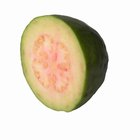
Sweet, tart pineapple can be eaten fresh, cooked into savory dishes or baked into fruity desserts. Fresh pineapples have a relatively short shelf-life, as they must be fully ripe to be picked. Once you cut into a pineapple, it starts to brown, or oxidize, quickly if it's not properly stored. If you don't plan on eating the pineapple you just purchased right away, it's important to store it in the fridge or freezer to help it retain its freshness.
Step 1
Keep the pineapple whole in the refrigerator for up to four days. Keeping the skin on the pineapple prevents oxidation until you're ready to eat or cook with it.
Step 2
Slice the pineapple and coat the slices with lemon juice; use a pastry brush or dip the slices in the juice. The ascorbic acid in the lemon juice slows down the browning that occurs when the flesh of pineapple is exposed to air. Store the slices in an airtight plastic container in the refrigerator for up to four days.
Step 3
Cut the pineapple into chunks and store it in a large freezer-safe resealable bag. Add as much fresh pineapple juice as possible to the bag, which helps the pineapple keep its flavor. Squeeze out the excess air from the bag before sealing it. You can store the pineapple in the freezer for up to one year.
Related Articles

How to Dry Pineapple in a Dehydrator

How to Bake Pineapple
How to Freeze Papaya

How to Store Leftover Pancake Batter

How to Store Apples

Fresh Homemade Orange Juice Will Stay ...

How to Keep Brown Plantains Fresh

How to Eat a Quince
How to Keep Cut Cabbage From Going Brown

How to Preserve Mangoes

How to Keep Fruit Salad Fresh

How to Juice Pineapple Skin

How to Freeze Peaches With a Vacuum ...

How to Keep Tomatoes Fresh

How Long Can You Keep Apples From ...

How to Cook Trevally

How to Marinate Pork Chops in Pineapple ...

How to Store Cooked Ground Beef

How to Cook Pork Hamonado

How to Peel Guava
References
Writer Bio
Based in Los Angeles, Zora Hughes has been writing travel, parenting, cooking and relationship articles since 2010. Her work includes writing city profiles for Groupon. She also writes screenplays and won the S. Randolph Playwriting Award in 2004. She holds a Bachelor of Arts in television writing/producing and a Master of Arts Management in entertainment media management, both from Columbia College.
Photo Credits
Burke/Triolo Productions/Brand X Pictures/Getty Images